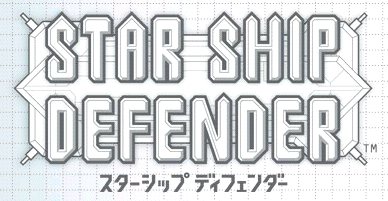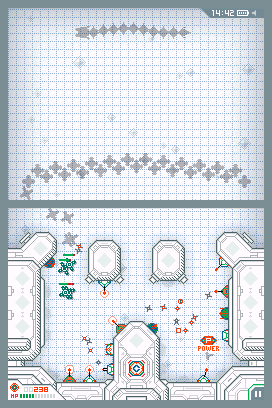Q-Games Queue: Starship Defense
 Monday, September 5, 2011 at 8:52PM
Monday, September 5, 2011 at 8:52PM Game #2 in my Q-Games queue is Starship Defense, a tower defense game made by the same people who created PixelJunk Monsters. I've never played PJMonsters, but after watching a few videos I've noticed quite a few similarities that helped me understand what I like most about Starship Defense. I won't bother explaining too much of the core tower defense gameplay. See this video to learn how to play. Again, I'll hit the highlights in bullet point fashion.

I know the game is called Starship Defense in the US, but it's close enough.
Overall Starship Defense's design is streamlined with a heavy emphasis on strategy and some tactical play. Recall that strategy is a specific plan of action generally geared to gain some kind of advantage, and tactics are general plans of action like "keep moving" or "just buy a lot of weapons." Obviously there is a spectrum that runs from the most general tactics to the most specific strategies. What's important to understand is that strategies are only possible when the player learns the specific complexities of the game. In general, the more complexities (units, rules, etc.) and interplay(counters) the more potential there is for a wide range of emergent strategies. Starship Defense offers enough depth and engaging gameplay to rival tower defense games on any platform.
The following are the highlights...
- Slots are positioned on and around fleet ship structures, which divide the playing field into unique shapes and paths. All weapons can only be placed on open slots. There are two different categories of weapons and two matching types of slots. Some levels are designed to limit the use of certain weapons because there were few advanced weapons slots on the map.
- Like Trajectile, the weapon design is very well-rounded. But like Pokemon, the way the weapon elements fill out the design space is uneven. The core categories for each weapon are speed, range, power, and the ability to hit stealth enemies. These properties are distributed unevenly to the basic weapon. And on top of this each weapon generally has a unique special property.
- Like the weapons, the enemies fulfill clear and unique roles. Some are designed to attack in great numbers, others for speed, others still for defense. A few are designed to directly counter specific weapons. Since any enemy can be cloaked, stealth enemies are doubly difficult to deal with. And depending on the arrangement of enemy units in a wave, their effectiveness can layer together.
- The graphical presentation and feedback design is very clean. The lifebars are absolutely essential for gauging enemy shield strength. Since all of the combat flows in real-time, seeing even the tiny lifebar drop is key. Like Trajectile, the color pallet only uses a few colors. Most of the screen is white with gray graph paper lines. Everything else may have blue, green, and red highlights. I love the style. The contrasting bits of color make the energy orbs, shield-repair items, and upgraded weapons stand out.
Launched from real-time strategy games, the gameplay of many tower defense games can best be understood as the combination of two opposite focuses; macro and micro strategies. Macro is the gameplay of the big picture including the push and pull of the battle, the economy growth, and even "build orders" (the order of buildings and weapons to use over time). Micro is management of individual units, weapons, and other small interactions on the map.

See how zoomed in this image is? We're looking at the micro level.
- The micro management gameplay isn't much compared to the macro gameplay, but this is generally how tower defense games are designed. In Starship Defense you must collect energy orbs to have enough resources to buy weapons (see orange dots in image above). You do this by touching the orbs on the touch screen. You can't be slow because energy orbs slowly slide down and off the screen after being dropped by enemies. Collecting orbs may seem like nothing because it's so easy. But when the action really built up and I was focused on other elements, I was surprised by how many slipped past me.
- For a few of the weapons you can slightly adjust the direction they point within a cone of about 45 degrees (see gray cone at the bottom of image above). Again, this may seem like nothing, but there are advanced techniques you can only pull off when you fine tune weapon ranges on this micro level. For example, to prevent a ghost laser (a basic weapon that can hit cloaked enemies) from attacking non-cloaked enemies when it has a choice between two targets, you may need to finesse the aim of multiple weapons.
- Another neat technique is upgrade juggling. Normally, upgrade items automatically snap onto your closest unupgraded weapon. The only way to preserve an upgrade item for later is to have all of your weapons upgraded. When this happens, you can continually reposition the falling upgrade item so it doesn't fall off the screen forever. It's like juggling! (This isn't the first time I described the gameplay of a Q-Games game as juggling). The main benefit for doing this is saving an upgrade so that you can buy more time, earn more money, and eventually buy a stronger weapon to upgrade.
- Finally, the last bit of micro is simply placing a weapon to specifically address real time threats and weaknesses in your defense.

This is the macro level "big picture." There's a lot to see and a lot going on.
- The macro gameplay of Starship Defense is much harder to describe. Such is the nature of anything "macro." In other words, because the macro level looks at the big picture, naturally there are more complexities to consider. Fortunately, here at Critical-Gaming we have all the language we need.
- Interesting choices emerge in gameplay with the help of interplay. As I've explained, the various types of units and weapons in Starship Defense counter each other in different ways. The gamer attempting to not only succeed but perfect a level must pay attention to the following elements when reading the battle field: enemy type, enemy wave order, enemy wave paths, available weapon slots, and the lifebars of enemies to gauge their strength. An upgrade here, an enemy there, or a blocked weapon slot can force you to adjust your strategy. Fortunately, there are plenty of ways to reach the goal.
- Each level throws 10 enemy waves at you. To aid in reading (strategic planning) the upcoming 5 waves and the final boss are displayed on the top screen. It's especially important to look out for waves of cloaked units as these enemies can really penetrate your defensive line if you're not prepared. Just before each wave attacks, the units display the path that they will take through the level. These visual elements do well in communicating key information to the player.
- There's a lot that you can read to develop strategies ahead of time. But there are also several elements that you must actively look for. Monitoring the life bars of enemies is important because about half way through the waves, the enemies increase in strength with no apparent visual cues. The incoming wave paths are a bit hard to see because of how they're drawn down the screen. The varied paths enemy waves can take may throw you off. Some enemies will attack your feet ships to drain your HP, but these areas aren't marked in their travel path. And there is some slight variation and randomness to account for from enemies and your weapons.
- When you're able to read the battle field well enough you can execute various macro level strategies. I developed an economic-build that sacrifices early HP and weapon upgrades to save money and boost the economy curve. This build it tough at first but the payoff increases the longer you can hold out. On some levels it's easy to implement a fast tech game where I upgrade to the most powerful weapons as quickly as possible. Every build and every choice I make is a balance of power, time, money, and HP.
After about 19 hours of play time I have earned "medal-perfects" on 24 out of 30 levels. Aside from the few levels with random asteroids and solar flares, Starship Defense is a solid strategy game. Like Trajectile, there are 3 main goals to pursue on each level. You can simply survive, you can earn a perfect by not letting a single enemy through, and if you don't use any special S.O.S. abilities while earning a perfect you'll earn a medal for the stage.
What I enjoy most about Starship Defense is slowly building up the complex macro level gameplay from such simple openings. Watching all the action play out and reading the battle field is akin to watching a galactic math equation factoring in rates and area formula to min-max my way to victory. I love how all of my choices are significant and interesting, which becomes increasingly apparently as my actions ripple forward into a future that I can see coming via the top screen.
Starship Defense is balanced. Polished. Finely tuned. And expertly crafted. At 5 bucks, Q-Games knock another one into deep space. Next up, PixelJunk Shooter 2.

